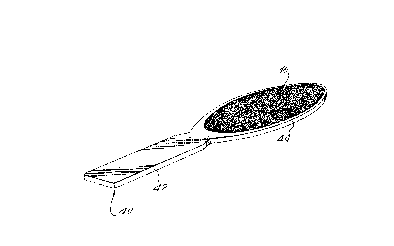Some of the information on this Web page has been provided by external sources. The Government of Canada is not responsible for the accuracy, reliability or currency of the information supplied by external sources. Users wishing to rely upon this information should consult directly with the source of the information. Content provided by external sources is not subject to official languages, privacy and accessibility requirements.
Any discrepancies in the text and image of the Claims and Abstract are due to differing posting times. Text of the Claims and Abstract are posted:
| (12) Patent: | (11) CA 2142949 |
|---|---|
| (54) English Title: | BEAUTY CARE INSTRUMENT |
| (54) French Title: | DISPOSITIF POUR SOINS DE BEAUTE |
| Status: | Term Expired - Post Grant Beyond Limit |
| (51) International Patent Classification (IPC): |
|
|---|---|
| (72) Inventors : |
|
| (73) Owners : |
|
| (71) Applicants : | |
| (74) Agent: | NORTON ROSE FULBRIGHT CANADA LLP/S.E.N.C.R.L., S.R.L. |
| (74) Associate agent: | |
| (45) Issued: | 1999-05-18 |
| (22) Filed Date: | 1995-02-20 |
| (41) Open to Public Inspection: | 1996-07-28 |
| Examination requested: | 1995-02-20 |
| Availability of licence: | N/A |
| Dedicated to the Public: | N/A |
| (25) Language of filing: | English |
| Patent Cooperation Treaty (PCT): | No |
|---|
| (30) Application Priority Data: | ||||||
|---|---|---|---|---|---|---|
|
A beauty care instrument, and in particular,
a device for manicure, pedicure, and false nail
applications which includes a fiberglass or Kevlar
substrate with thicknesses ranging from .020 inches to
.125 inches in which the flexibility is varied and a
single layer of uniform diamond grit size is embedded
on at least a surface of the substrate and the grit
ranges from 30 to 1200 mesh.
Cette invention concerne un instrument de soins de beauté et, en particulier, un instrument à manucure/pédicure pouvant également servir à traiter les ongles artificiels. Il se compose d'un substrat en fibre de verre ou kevlar dont l'épaisseur varie entre ,020 et ,125 pouces, dont la flexibilité est également variable et qui porte sur au moins une face une couche unique de poudre de diamant dont la grosseur des grains va de 30 à 1200.
Note: Claims are shown in the official language in which they were submitted.
Note: Descriptions are shown in the official language in which they were submitted.

2024-08-01:As part of the Next Generation Patents (NGP) transition, the Canadian Patents Database (CPD) now contains a more detailed Event History, which replicates the Event Log of our new back-office solution.
Please note that "Inactive:" events refers to events no longer in use in our new back-office solution.
For a clearer understanding of the status of the application/patent presented on this page, the site Disclaimer , as well as the definitions for Patent , Event History , Maintenance Fee and Payment History should be consulted.
| Description | Date |
|---|---|
| Inactive: Expired (new Act pat) | 2015-02-20 |
| Inactive: Office letter | 2006-07-24 |
| Inactive: Payment - Insufficient fee | 2006-07-11 |
| Inactive: Reversal of deemed expired status | 2006-05-23 |
| Inactive: Payment - Insufficient fee | 2006-05-11 |
| Inactive: Entity size changed | 2006-05-11 |
| Letter Sent | 2006-05-01 |
| Inactive: Entity size changed | 2006-04-12 |
| Inactive: Late MF processed | 2006-04-12 |
| Inactive: Late MF processed | 2006-04-12 |
| Inactive: Corrective payment - s.78.6 Act | 2006-04-12 |
| Inactive: Corrective payment - s.78.6 Act | 2006-04-12 |
| Time Limit for Reversal Expired | 2006-02-20 |
| Letter Sent | 2006-02-20 |
| Letter Sent | 2005-02-21 |
| Grant by Issuance | 1999-05-18 |
| Inactive: Cover page published | 1999-05-17 |
| Inactive: Final fee received | 1999-02-16 |
| Pre-grant | 1999-02-16 |
| Notice of Allowance is Issued | 1998-08-25 |
| Letter Sent | 1998-08-25 |
| Notice of Allowance is Issued | 1998-08-25 |
| Inactive: Status info is complete as of Log entry date | 1998-08-20 |
| Inactive: Application prosecuted on TS as of Log entry date | 1998-08-20 |
| Inactive: Approved for allowance (AFA) | 1998-07-03 |
| Application Published (Open to Public Inspection) | 1996-07-28 |
| Request for Examination Requirements Determined Compliant | 1995-02-20 |
| All Requirements for Examination Determined Compliant | 1995-02-20 |
There is no abandonment history.
The last payment was received on 1999-02-08
Note : If the full payment has not been received on or before the date indicated, a further fee may be required which may be one of the following
Patent fees are adjusted on the 1st of January every year. The amounts above are the current amounts if received by December 31 of the current year.
Please refer to the CIPO
Patent Fees
web page to see all current fee amounts.
Note: Records showing the ownership history in alphabetical order.
| Current Owners on Record |
|---|
| GINETTE GODBOUT |
| Past Owners on Record |
|---|
| None |